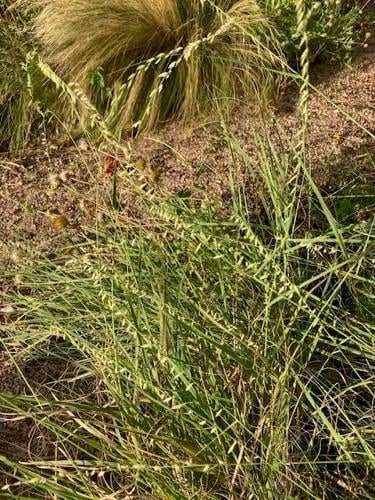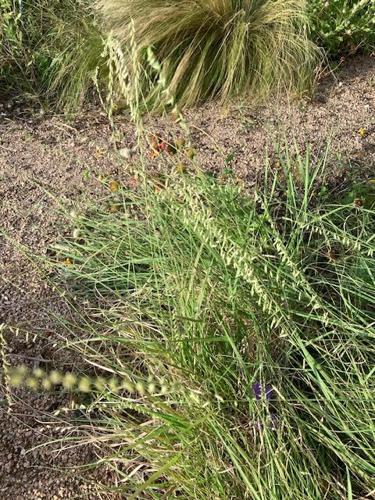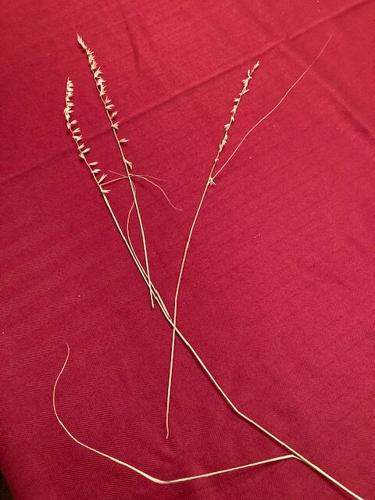STATE GRASS
Sideoats Grama: the Texas State Grass
- By Olivia Blanchard | Victoria County Master Gardener
- Sep 9, 2023 (Read as pdf)

PHOTOS BY VICTORIA COUNTY MASTER GARDENER/OLIVIA BLANCHARD
Sideoats Grama at Victoria Educational Gardens


Sideoats Grama taken from the Victoria Educational Gardens
STATE GRASS
Sideoats Grama: the Texas State Grass
By Olivia Blanchard | Victoria County Master Gardener Sep 9, 2023
In 1971 the Texas Legislature focused on Texas farmlands, meadows and rangelands. Texas needed a grass for different soils, pastures, wildlife preservation, recovery crops, rainfall variances and durability. Sideoats grama (Boutiloua curtipendula) became the grass of choice and was officially named the Texas state grass.
The scientific name refers to two Spanish botanists (Boutelou). The curtipendula is derived from curtis meaning shortened while pendidula meaning hanging. Those conspicuous, side-hanging seeds leave no doubt about the grass’ name.
Early Texas settlers initiated the name “sideoats” and grama was added. During these times, ranching was a major industry in Texas. Since native grasses sustain livestock, this grass has several positive features.
Sideoats grama has the ability:
To flourish in diverse soil conditions;
To provide high quality forage;
To grow as a perennial;
To survive in wintry conditions;
To endure periods of drought;
To reseed;
To grow in depleted grasslands.
This plant ranges from Southern Canada, through most of the United States and Central America and as far south as Argentina. This forage nourished roaming herds of bison, elk, antelope, cattle and horses.
In Texas, Ssdeoats grama is abundant in Blackland Prairies, Cross Timbers, Edwards Plateau, Rolling Plains, High Plains and Trans Pecos. This grass does need well-draining soil.
Sideoats grama grows to a height of 2 to 3 feet. If conditions are favorable, it can grow taller.
The root system is very fibrous and may attain a depth of 4-feet in good conditions. This type of root system is effective in erosion control from winds and flooding. In wash-out areas, the roots can prevent soil loss.
In drought periods, long roots can access deep moisture. The wide spread of 1 to 1.5-feet helps this plant adapt to dry conditions.
The rough leaves are a quarter inch wide and 8 to 12-inches in length. Scattered white hairs are located at the leaf base. This native Texas plant has a high resistance to diseases.
Each clump of grass ranges from 8 to 11-inches wide. Overtime, the clumps expand slowly from the base on short, fat rhizomes. Erect leaf stems grow to a 2-to 3-foot height. The cluster also puts out upright, long growths where the spikelets are located.
The spikelets are the seed producers. The leafless stalk will have a zigzag pattern. The seed form on the side of the stem. The number of seeds on each stalk varies.
Grasses do bloom. However, most grasses are wind pollinated and do not require pollinator insects for fertilization. Sideoats grama has small showy red, purple or orange flowers. They bloom in a large cluster making the colors noticeable.
Blooms occur from June to November. The seed color changes from purplish to tan in the winter. The fruit resembles oat seed and hangs on one side of the stem. Since this grass reseeds itself, it has been used to replenish depleted rangelands.
The plant parts are invaluable for wildlife. The seeds sustain songbirds, turkeys and quail from summer through winter. Animals use grass as cover protection and nest building.
As a garden accent, Sideoats has a manageable size and shape. The low growth pattern allows spring flowers to be seen. Cone flowers and black-eyed Susan wildflowers make great companion flowers.
Full sun is best, but this grass tolerates dappled shade. Once it is established, do not over water it. This grass tolerates high and low temperatures and varied soil conditions.
Sideoats grama stops growing by frost. You can trim it to 8-inches tall in late winter or early spring. Some viable seeds will germinate. You can also propagate this grass by clump division.
You can see sideoats grama growing in the Native Garden at Victoria Educational Gardens. It is a significant asset in our Native Texas flora and deserves to be the Texas state grass.
The Gardeners’ Dirt is written by members of the Victoria County Master Gardener Association, an educational outreach of Texas A&M AgriLife Extension – Victoria County. Mail your questions in care of the Advocate, P.O. Box 1518, Victoria, TX 77901; or [email protected], or comment on this column at VictoriaAdvocate.com.
References:
navasotaexaminer.com/article/community-columns/bouteloua-curtipendula-state-grass-texas
growitbuildit.com/sideoats-grama-bouteloua-curtipendula
authentictexas.com/sideoats-official-state-grass-of-texas
https://plants.usda.gov/DocumentLibrary/plantguide/pdf/pg_bocu.pdf